Physical Address
304 North Cardinal St.
Dorchester Center, MA 02124
Physical Address
304 North Cardinal St.
Dorchester Center, MA 02124

Prepare to save thousands of dollars and countless headaches by discovering why seasoned RV owners warn against making this expensive mistake.
You’ve probably dreamed about hitting the open road in your own RV, imagining the freedom and adventure that comes with mobile living. Before you sign those financing papers, though, you’ll want to reflect on some sobering realities that many RV owners wish they’d known sooner. From hidden costs that can drain your savings to lifestyle challenges that test even the strongest relationships, there’s more to RV ownership than glossy brochures and Instagram-worthy moments suggest. Let’s explore why your RV dreams might be better left as just that—dreams.
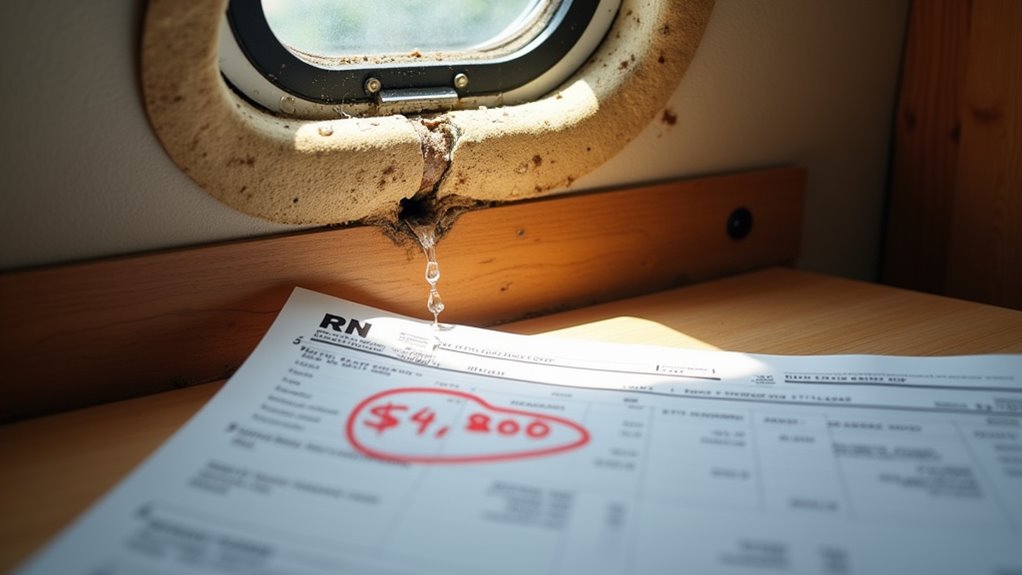
While the dream of hitting the open road in an RV might seem appealing, the true financial commitment extends far beyond the sticker price.
You’ll face high-interest financing rates, often 10% or higher, which can add hundreds to your monthly payments. Insurance premiums will cost more than your regular vehicle due to the RV’s size and value.
Don’t forget the $1,000 average annual maintenance costs, plus unexpected repairs that can quickly drain your savings. Annual carrying costs including storage and insurance typically run $1,178.
You’ll need to budget for storage fees if you can’t park at home, and campground rates of $30-50 per night add up fast. Full-time RV living requires careful financial planning to manage these ongoing expenses.
Factor in poor fuel efficiency and operating costs like propane and oil changes, and you’re looking at potential nightly travel expenses exceeding $290.
These ongoing costs can easily amount to thousands of dollars annually.
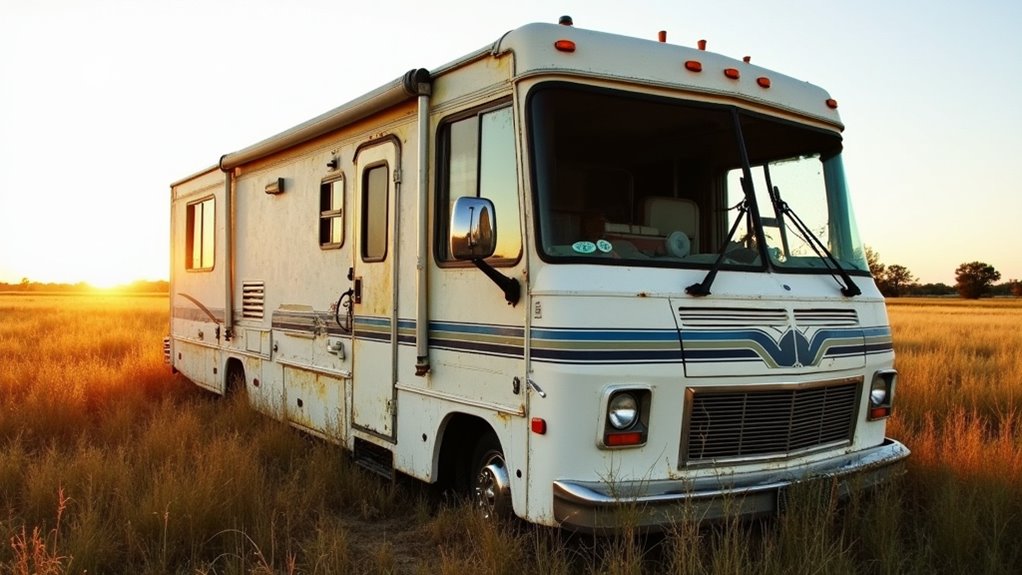
Unlike a traditional home that might appreciate over time, your RV investment faces a harsh reality of rapid depreciation that’ll shock many first-time buyers.
You’re looking at a staggering 20% drop in value during the first year alone, with continued losses reaching up to 75% over a decade. Used RV inspections can help buyers avoid purchasing heavily depreciated units with hidden problems.
Prepare for a financial gut punch: your new RV’s value plummets 20% in year one, spiraling down to a brutal 75% loss after ten years.
Fifth-wheel RVs show a particularly steep 71% depreciation after ten years of ownership.
The smartest move? Consider buying used to let someone else absorb that initial depreciation hit.

Before you commit to RV life, you’ll need to face the relentless demands of maintenance and repairs that come with owning what’s fundamentally a house on wheels.
You’re looking at average maintenance costs exceeding $3,400 over five years, with full-timers spending around $1,379 monthly on repairs and upkeep.
Your RV combines complex automotive and home systems, requiring constant attention to electrical, plumbing, and HVAC components.
While travel trailers offer more affordability than motorhomes, they still require substantial ongoing maintenance.
The typical ownership requires monthly truck payments around $979, adding significant financial strain to your maintenance budget.
You’ll deal with expensive specialized parts, high labor costs for skilled technicians, and regular preventative maintenance to avoid catastrophic failures.
Tire replacements, wheel bearing services, and seasonal inspections will become your new routine.
Don’t forget the impact on your travel plans – frequent repairs mean less time enjoying the open road and more time stuck at service centers.
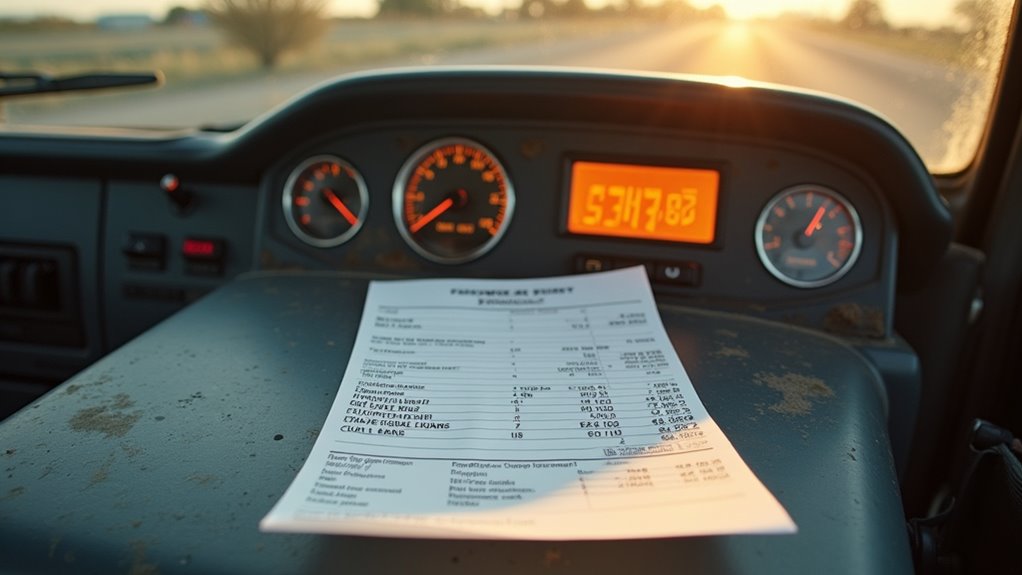
When you’re calculating the true cost of RV travel, fuel expenses can quickly drain your budget, especially with larger motorhomes guzzling gas at just 6-10 miles per gallon.
A typical 3,000-mile adventure will set you back nearly $1,000 in fuel costs alone, and that’s before considering maintenance, insurance, and campsite fees. Proper tire inflation and regular maintenance checks are essential to avoid wasting even more fuel during your trips. Many travelers skip RV ownership entirely due to these overwhelming expenses.
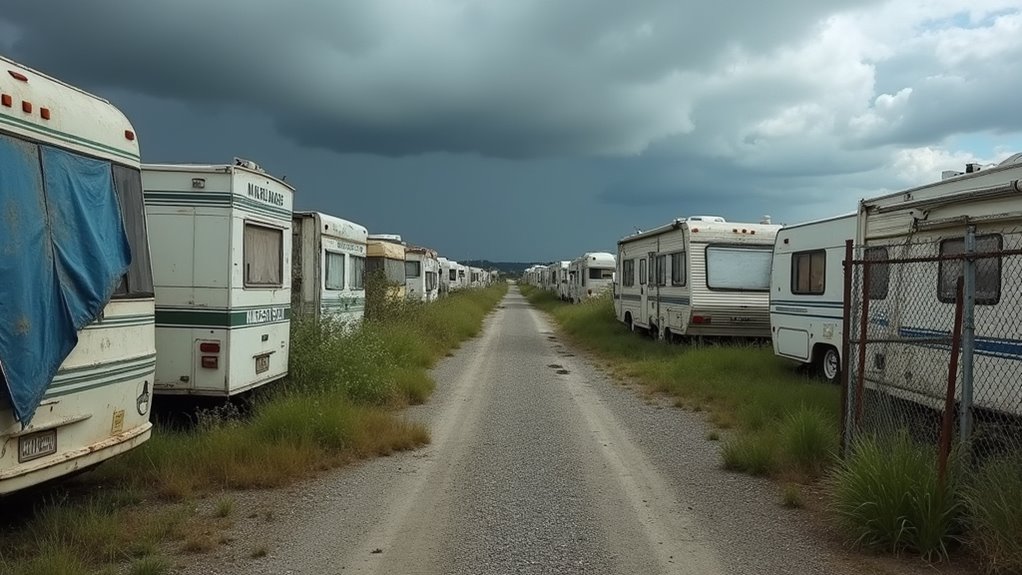
Finding a place to store your RV has become increasingly challenging as storage facilities struggle to keep up with surging demand.
While RV ownership has jumped 22% in recent years, storage facilities have only grown by 9.8%, creating a severe shortage of available spaces.
You’ll face multiple hurdles when seeking storage. Most HOAs and local zoning laws prohibit parking RVs at your home, forcing you to seek commercial options.
But dedicated facilities are scarce – only 1,380 exist across 42 states – and they’re usually full.
When you do find a spot, you’ll pay premium rates, as storage prices have doubled to nearly $1 million per acre.
Plus, many facilities are inconveniently located and have restricted access hours, making spontaneous trips difficult.
The industry has seen over 11 million households now owning RVs, setting a record high in 2022 and making the storage crunch even more severe.
It’s a storage nightmare that’s only getting worse.
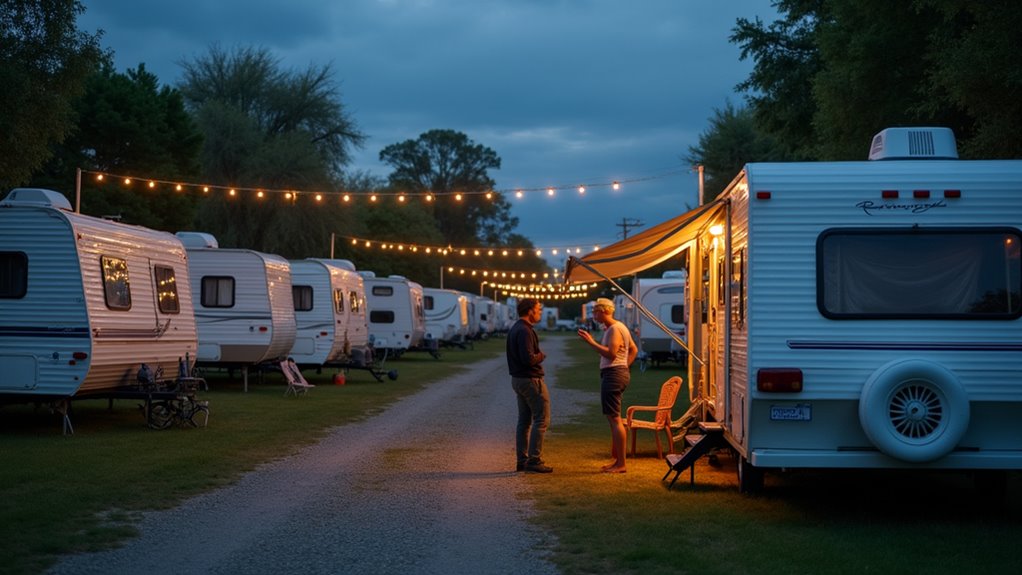
Despite the idyllic images of peaceful camping spots, today’s RV campgrounds have become increasingly crowded battlegrounds for limited sites.
You’ll face fierce competition, with average occupancy rates hitting 68% year-round and soaring to nearly 100% during peak seasons.
Many family-friendly campgrounds are particularly impacted by overcrowding, making it harder to find suitable spots for children.
The reality is, you’re entering an oversaturated market where finding a spot has become a major challenge, with 54% of operators forecasting even higher occupancy rates in 2024 compared to 2022.
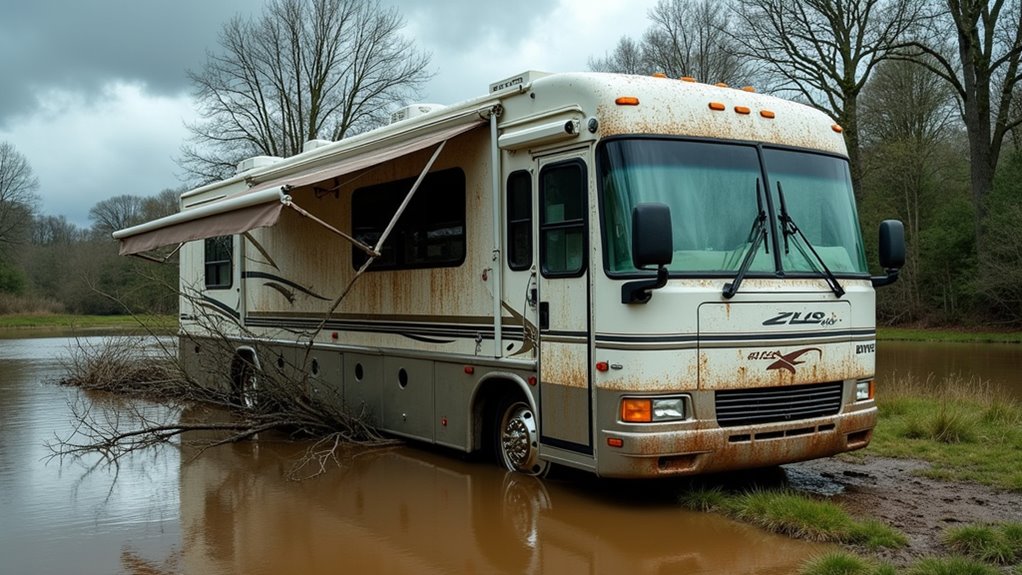
Beyond the challenge of securing a campsite, Mother Nature presents an even more formidable obstacle for RV owners.
You’ll face constant weather threats that permanent homes simply don’t experience. Your RV’s structure isn’t built to withstand severe storms, high winds, or hail, making you vulnerable during extreme weather events.
Understanding your RV park’s climate vulnerability index can help you make informed decisions about seasonal travel and risk management.
You’re also restricted by seasons. Winter brings freezing risks to water systems, requiring costly winterization, while many campgrounds simply shut down. Safe winter driving requires extensive preparation and specialized equipment for RV owners.
Summer isn’t much better – your RV can become dangerously hot, straining air conditioning systems and your energy budget.
When severe weather strikes, you’ll find limited emergency shelter options at most RV parks, and evacuation routes might be blocked.
Weather-damaged roads and infrastructure create additional hazards, potentially forcing you onto dangerous detours unsuitable for your rig’s size.
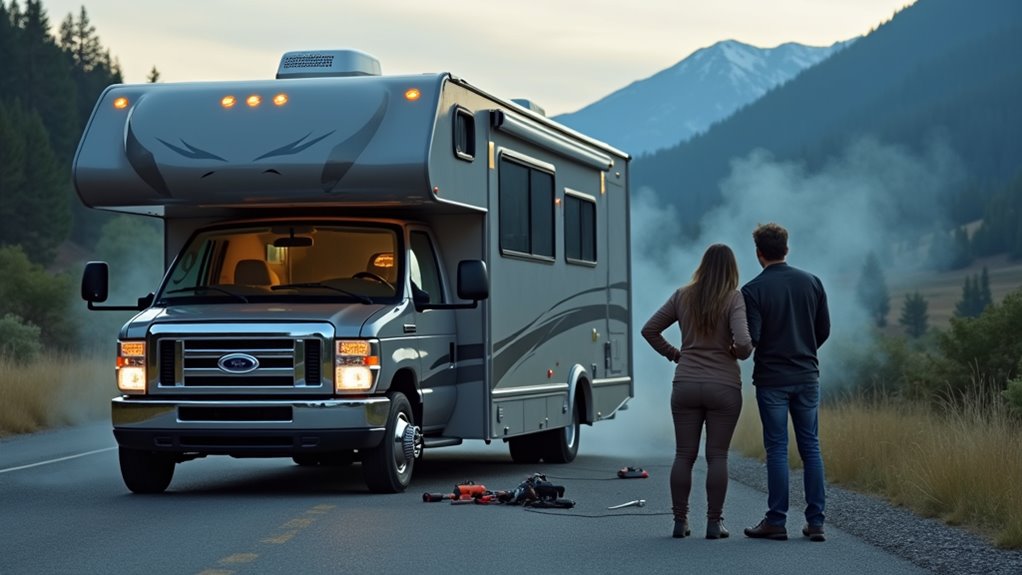
When your RV breaks down, you’ll quickly discover one of the industry’s biggest problems: a severe shortage of qualified mechanics.
With over 10 million RVs on the road but only about 15,000 technicians nationwide, you’re facing an uphill battle to get timely repairs.
The staggering imbalance between RVs and qualified technicians creates a nationwide service bottleneck, leaving owners scrambling for repairs.
This shortage isn’t improving anytime soon, making RV ownership increasingly frustrating and potentially costly. The industry needs are particularly dire since RV service technician became the third-fastest growing job in 2020, yet demand still far exceeds supply.

Insuring and registering an RV isn’t just another routine vehicle expense – it’s a complex maze of regulations, rising costs, and potential coverage gaps that can drain your wallet.
You’ll face steep premiums that are climbing even higher due to inflation and market conditions, especially for motorhomes. Modern insurers now offer usage-based insurance options that track your driving patterns and mileage. Finding affordable coverage options requires extensive research and comparison shopping. If you’re planning to live full-time in your RV or rent it out through peer-to-peer services, you’ll need special endorsements that further increase costs.
Plus, many insurers are tightening their underwriting criteria and excluding coverage for off-grid adventures.
Registration adds another layer of complexity, with requirements varying by state. You might need annual inspections, emissions testing, and complex documentation.
Factor in the possibility of out-of-state registration for tax purposes, and you’re looking at a bureaucratic headache that can quickly become overwhelming.
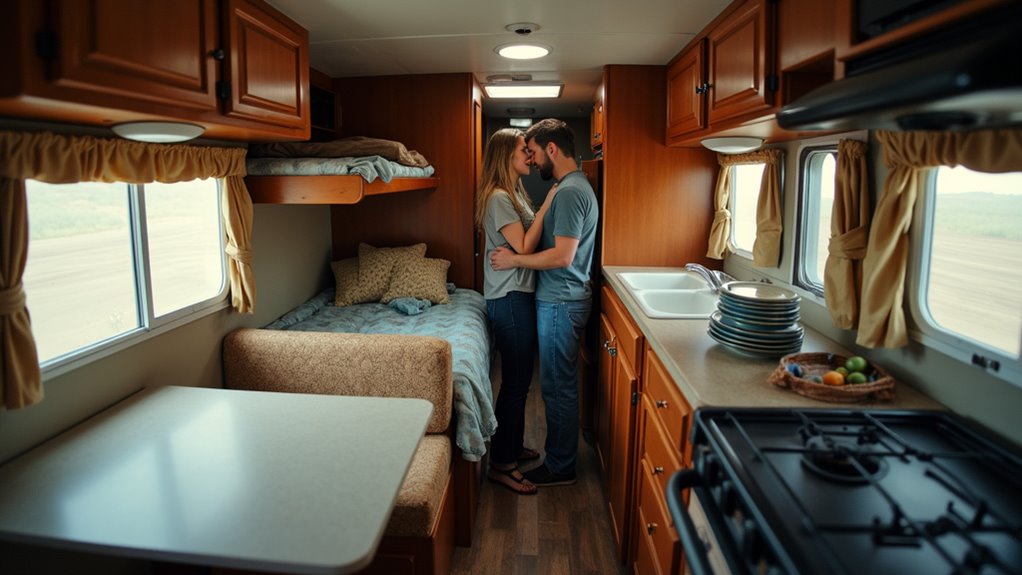
Although the glamorous #VanLife photos on social media showcase spacious-looking RV interiors, the reality of living in one means drastically downsizing your living space and sacrificing many common household comforts.
You’ll quickly discover that RV living requires significant lifestyle adjustments that can impact your daily routines and overall well-being. Living in smaller quarters often leads to travel fatigue and emotional stress. Families with young children face additional challenges managing limited space and maintaining daily routines.
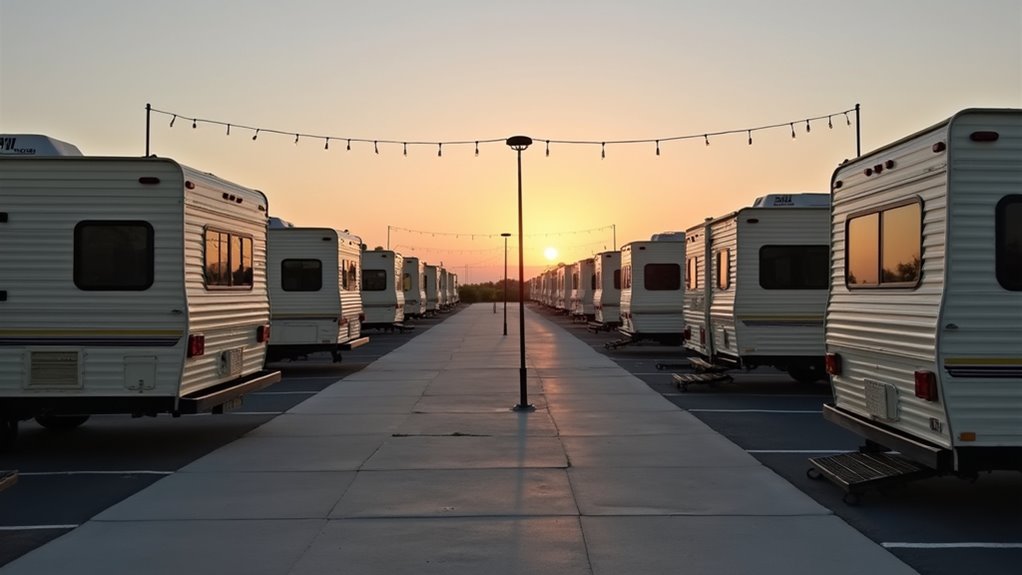
Despite the allure of freedom on the open road, living in an RV can lead to significant social disconnection and a profound sense of community loss.
You’ll find yourself physically separated from family and friends, missing important life events and regular gatherings that strengthen relationships.
The nomadic lifestyle makes it challenging to build lasting connections or put down roots in any community.
While RV clubs and group camping trips offer temporary social interactions, they can’t replace the deep bonds formed through consistent, long-term community engagement.
Research shows this isolation can seriously impact your health, increasing risks of depression, anxiety, and cognitive decline.
Though technology helps you stay in touch, it’s not the same as face-to-face interactions. This contradicts studies showing that shared outdoor experiences are vital for strengthening family relationships and emotional well-being.
You’ll miss out on local activities, support networks, and the comfort of familiar faces in your daily life.
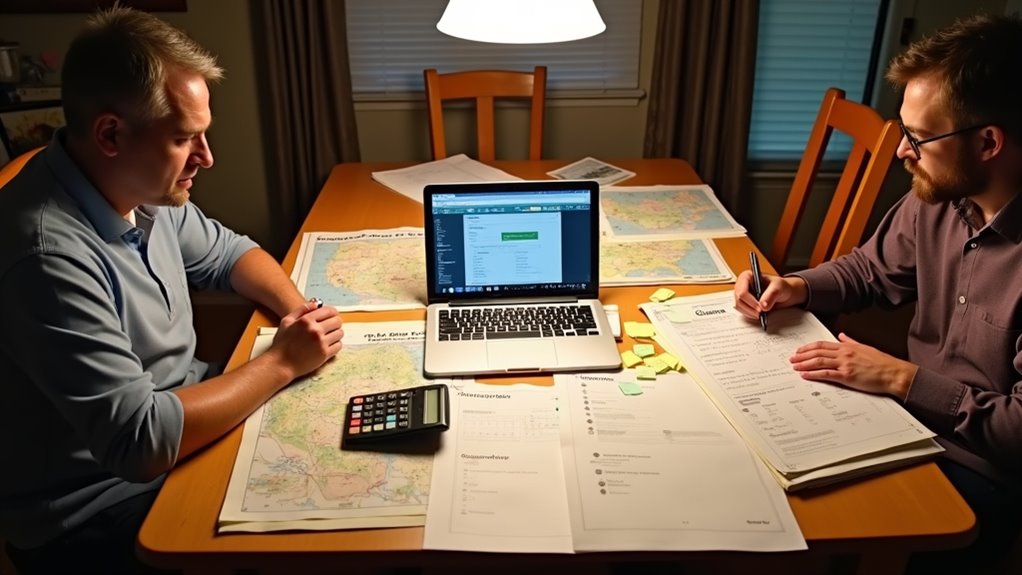
While disconnection from community life poses significant challenges, the sheer amount of planning required for RV travel can quickly become overwhelming.
You’ll need to invest countless hours researching routes, coordinating stops, and securing reservations – often months in advance. The mental burden of managing these complex logistics can turn your dream vacation into a stressful planning marathon. With 72 million Americans planning RV trips in the coming year, competition for prime camping spots is fiercer than ever. Instead of stressing over trip planning, many RV owners are discovering that rental income opportunities can offset their ownership costs.

Once you’ve committed to RV travel, you’ll quickly discover that spontaneous adventures become nearly impossible.
You’ll need to book popular campgrounds months in advance, often competing with thousands of others when reservation systems open. Many spots fill within minutes, leaving you with no flexibility to extend your stay or make last-minute changes. Despite data showing that 45% of RVers plan trips less than two months ahead, finding available sites remains challenging.
Weather and seasonal closures further restrict your freedom, as many parks shut down or limit services during off-seasons. While long-term rentals can provide stability, they often require extensive advance planning.
You can’t simply pull over anywhere – RV size restrictions, bridge heights, and road conditions dictate your route choices. Even a simple detour requires careful planning for parking and hookups.
The days of hitting the open road on a whim are replaced by constant reliance on reservation apps, booking systems, and detailed route planning.

Living in an RV can profoundly strain family relationships rather than strengthen them. The constant proximity in cramped quarters often amplifies minor irritations into major conflicts, while the lack of personal space leaves family members without a retreat to decompress.
Cramped RV living intensifies family tensions, turning small annoyances into heated disputes while offering no sanctuary for mental recovery.
While 40% of RVers seek relaxation during their travels, the reality often proves stressful and overwhelming. You’ll find that managing daily logistics and unexpected repairs creates a pressure cooker of stress that can test even the strongest family bonds.
Unlike traveling to family resorts, RV life lacks the structured activities and amenities that help children thrive during family trips.
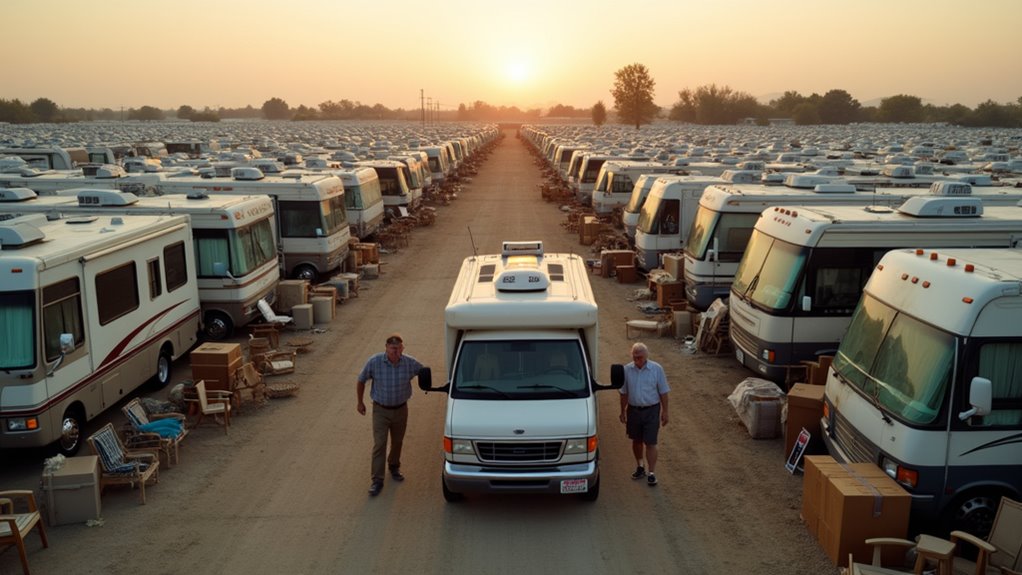
Although downsizing for RV life might seem liberating at first, you’ll quickly discover it’s an endless cycle of stress and difficult decisions.
You’ll constantly battle emotional attachments to belongings while managing limited storage space, leading to perpetual decluttering and organization challenges. Children’s toys like Tonka trucks become particularly problematic as you struggle to find adequate storage solutions.
The mental toll adds up fast. You’ll face decision fatigue from repeatedly choosing what to keep or discard, and the emotional strain of parting with sentimental items never really goes away.
Even after initial downsizing, you’ll find yourself continuously reassessing possessions as space constraints become more apparent.
What started as a dream of simplification often turns into an ongoing source of anxiety.
You’ll sacrifice cherished hobbies, important tools, and comfort items while struggling to maintain an organized living space in your cramped quarters.
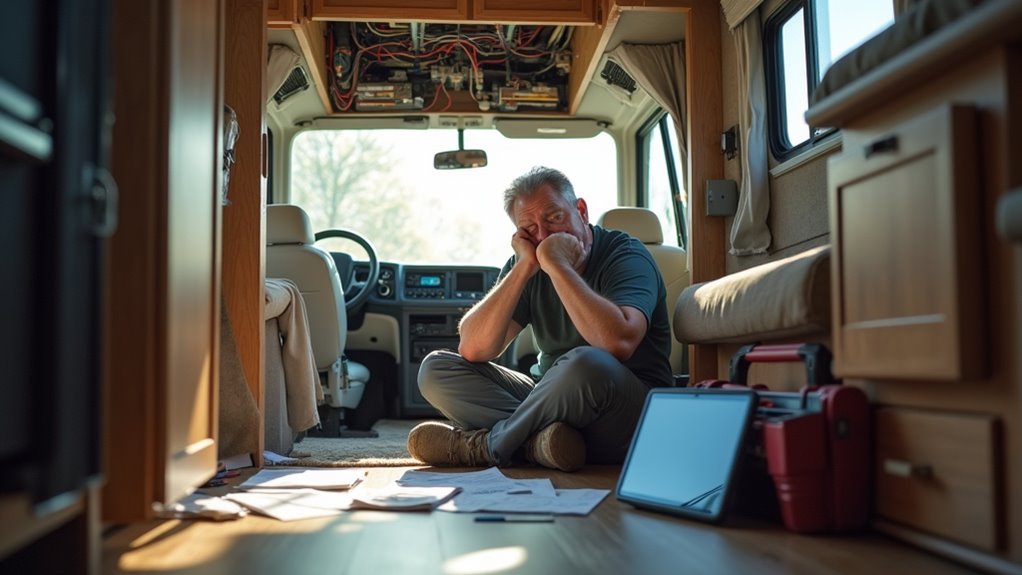
Modern RVs pack an overwhelming array of complex systems that you’ll need to master, from electrical and plumbing networks to heating, cooling, and entertainment components.
With the rise of sustainable electric solutions, managing power systems has become even more complex as manufacturers integrate new zero-emission technologies and charging requirements.
You’re fundamentally managing a mobile home filled with technology that requires constant attention and maintenance. Common issues like AC fan failures can leave you stranded without cooling in warm weather.
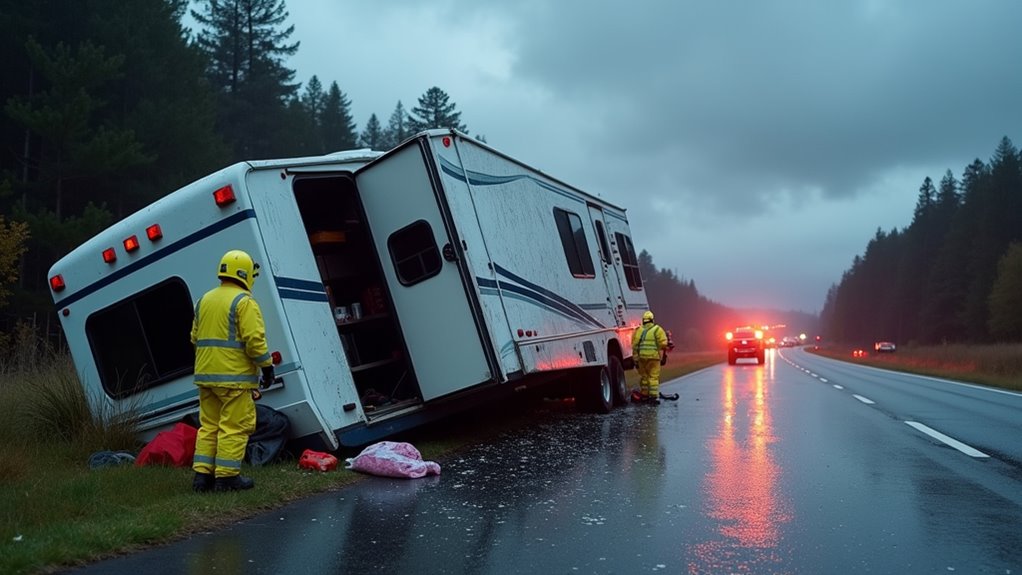
Whether you’re a seasoned traveler or new to RV life, the health and safety risks of mobile living can’t be ignored.
You’ll face serious hazards from fire and carbon monoxide, especially in confined spaces with propane systems and gas appliances. Regularly checking your smoke detector batteries and keeping spares on hand is critical for fire safety. The road itself presents major dangers, with RV accidents causing thousands of injuries annually from head trauma, spinal injuries, and internal damage.
Your physical and mental health may deteriorate due to prolonged driving, limited exercise options, and poor dietary habits. The constant stress of planning, repairs, and tight living quarters can trigger anxiety and depression. Unpleasant sewer gas odors around your RV can also create an unhealthy living environment.
Remote locations often mean delayed emergency response times and limited healthcare access. Security concerns at campgrounds and boondocking sites, combined with challenging road conditions, create additional risks you’ll need to carefully consider.
RV ownership isn’t the carefree lifestyle you’ve seen in glossy brochures. With studies showing that RVs typically lose 30% of their value in just three years, you’re looking at a significant financial hit from day one. Beyond the depreciation, you’ll face mounting costs for maintenance, storage, and fuel. Before jumping into the RV lifestyle, consider whether those Instagram-worthy moments are worth the real-world challenges and financial strain.